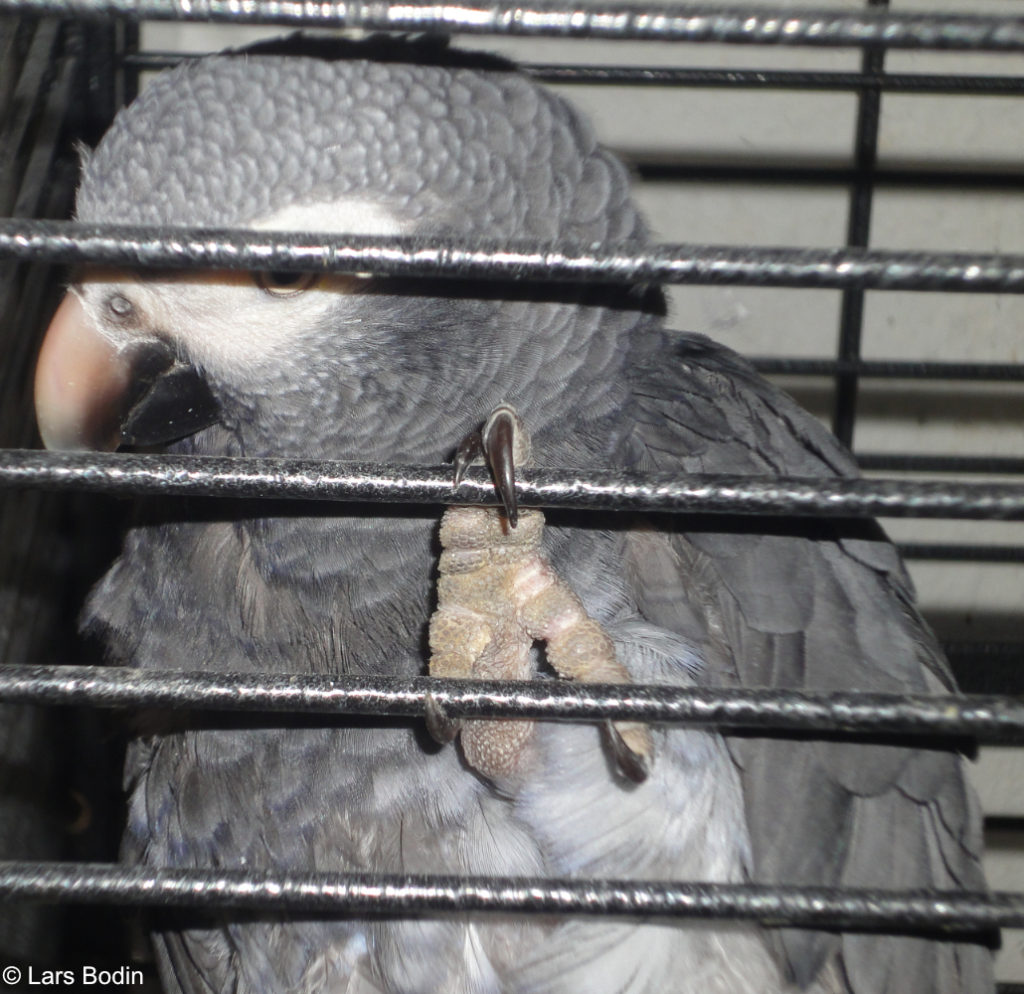How to trim the claws

Make sure to provide plenty of natural wood perches (see this page on bird-safe plants!) as this helps keeping the claws at a proper length.
If the claws grow too long it can become very uncomfortable for the bird and lead to problems with the claws getting caught in your clothes or even the mesh of the cage in some cases – I have seen some birds where the claws was so long and twisted that they reminded me of a corkscrew. That kind of neglect is a crime!
I highly recommend you also visit this page for more information about how to trim the claws.
By trimming the claws regularly you will also avoid getting scratches on your arms or hands by too sharp claws so it is a win-win to ensure the claws are in proper shape!
When you buy a new cage for a bird it will often come with a few perches made of plastic or hard smooth tree. Start by trowing them in the garbage bin and replace them with perches from natural branches. Make sure you do not use branches from anything poisonous to parrots!
You can also buy special perches in the pet store e.g. the “Sandy Perch” that help grinding the claws so you do not have to trim so often.

The quick is a blood vessel and nerve that grows inside part of the nail. DO NOT cut into the quick as it will start bleeding and also cause pain! Only make small cuts and ONLY if you are certain to not cut too close to the quick!
Before you start trimming
Notice that inside a birds nail there is a “quick” which is the nerve ending in the nail. If you cut into the quick it will hurt the bird and start bleeding – this can be fatal if the bleeding is not stopped quickly! For this reason it is very important that you buy some styptic powder at your local pet shop or veterinarian, e.g. “Kwik Stop“; styptic powder will quickly stop the bleeding and also
For small parrots you can use your own nail clipper but for larger claws I recommend that you buy a stronger nail clippers at your pet shop instead.
Place the parrot on your hand and hold it close to a light – this way it is easier to see the quick inside the talon. Notice how close the quick is to the tip of the claw. On some parrots it is very easy to see a small red line in the talon but on species with darker talons it can be very difficult. If you are not certain then STOP! Go visit your vet instead.
If your parrot is not tame, you may have to wrap it carefully in a white towel to make sure it sits still while you are cutting. I highly recommend you have a friend holding the parrot in the towel while you concentrate on cutting the nails. Be gentle and talk to the bird with a soft voice to keep it as calm as possible. If the parrot becomes too stressed then STOP! You will have to continue another day.
DO NOT cut too much of the nail in one cut – it is better to make small cuts (like 0,5 – 1 mm) and each time check that you are not getting too near the quick.
In case of an accident
Apply some Kwik Stop or similar kind of styptic powder – this will cause the quick to contract further into the claw and clots the blood. It also helps avoiding bacteria from the surrounding area. Kwik Stop also contains benzocaine for pain relief.
If you do not have any styptic powder you can use corn starch in an emergency. If you don’t have any corn starch then use flour.
Make sure to disinfect the cage and perches etc. if you have an accident while trimming!
How to trim nails Ninja style
Many parrots do not like to have their claws trimmed so in many cases it is recommended to wrap the bird in a towel before trimming but this can also be very stressful for some birds.
One of my parrots hate having her claws trimmed but as she is very tame I use this Ninja technique instead:
While the bird is sitting on my hand or finger I keep talking with a soft voice to attract hers attention while the other hand slowly approach the targeted nail and carefully cut just the tip of the nail. I then give her a small snack to reward her for sitting still while cutting. After I have cut a few nails she decides she doesn’t like it and fly away – then I take a break and try again a little later.
Another method can be used when the bird is her cage. I then lure her into climbing on the side of the cage and cuddle her cheek or neck while talking to her to keep her distracted. I then slowly and carefully move my other hand with the nail clipper closer to her claws (that she is using to hang in the bars or mesh on the side of the cage). In most cases she doesn’t even notice that I trim her nail – she is too buzy enjoying the cuddling.
If you have an assistent (e.g. my daughter) the second approach can be made even easier by one person cuddling and talking while the other move in silently like a Ninja and now have both hands free to trim the nails.

